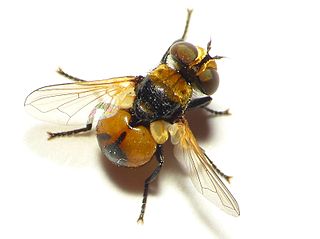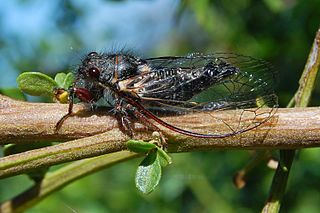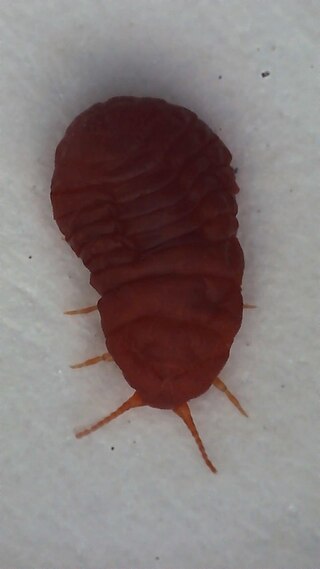
Scale insects are small insects of the order Hemiptera, suborder Sternorrhyncha. Of dramatically variable appearance and extreme sexual dimorphism, they comprise the infraorder Coccomorpha which is considered a more convenient grouping than the superfamily Coccoidea due to taxonomic uncertainties. Adult females typically have soft bodies and no limbs, and are concealed underneath domed scales, extruding quantities of wax for protection. Some species are hermaphroditic, with a combined ovotestis instead of separate ovaries and testes. Males, in the species where they occur, have legs and sometimes wings, and resemble small flies. Scale insects are herbivores, piercing plant tissues with their mouthparts and remaining in one place, feeding on sap. The excess fluid they imbibe is secreted as honeydew on which sooty mold tends to grow. The insects often have a mutualistic relationship with ants, which feed on the honeydew and protect them from predators. There are about 8,000 described species.

The Margarodidae or ground pearls are a family of scale insects within the superfamily Coccoidea. Members of the family include the Polish cochineal and Armenian cochineal and the original ground pearl genus, Margarodes. Beginning in 1880, a number of distinct subfamilies were recognized, with the giant coccids being the first. Although Maskell proposed a new family, many continued to regard the monophlebids as a mere subfamily for many years, and the Margarodidae classification continued to be polyphyletic through the 20th Century. Since then, taking the advice of Koteja several subfamilies and tribes have been elevated into their own families such as Matsucoccidae and Xylococcidae. The pared-down family of Margarodidae is monophyletic.

Theodore Dru Alison Cockerell (1866–1948) was an entomologist and systematic biologist who published nearly 4,000 papers, some of them only a few lines long. Cockerell's speciality was the insect order Hymenoptera, an area of study where he described specimens from the United States, the West Indies, Honduras, the Philippines, Africa, and Asia. Cockerell named at least 5,500 species and varieties of bees and almost 150 genera and subgenera, representing over a quarter of all species of bees known during his lifetime. In addition to his extensive studies of bees, he published papers on scale insects, slugs, moths, fish scales, fungi, roses and other flowers, mollusks, and a wide variety of other plants and animals.
Paleontology or palaeontology is the study of prehistoric life forms on Earth through the examination of plant and animal fossils. This includes the study of body fossils, tracks (ichnites), burrows, cast-off parts, fossilised feces (coprolites), palynomorphs and chemical residues. Because humans have encountered fossils for millennia, paleontology has a long history both before and after becoming formalized as a science. This article records significant discoveries and events related to paleontology that occurred or were published in the year 1931.

Diaspididae is the largest family of scale insects with over 2650 described species in around 400 genera. As with all scale insects, the female produces a waxy protective scale beneath which it feeds on its host plant. Diaspidid scales are far more substantial than those of most other families, incorporating the exuviae from the first two nymphal instars and sometimes faecal matter and fragments of the host plant. These can be complex and extremely waterproof structures rather resembling a suit of armor. For this reason these insects are commonly referred to as armored scale insects. As it is so robust and firmly attached to the host plant, the scale often persists long after the insect has died.

The Coccidae are a family of scale insects belonging to the superfamily Coccoidea. They are commonly known as soft scales, wax scales or tortoise scales. The females are flat with elongated oval bodies and a smooth integument which may be covered with wax. In some genera they possess legs but in others, they do not, and the antennae may be shortened or missing. The males may be winged or wingless.

Cistogaster is a genus of tachinid flies in the family Tachinidae. Known hosts are Hemiptera of the genus Aelia sp..

Halimococcidae is a family of scale insects in the order Hemiptera. Members of the family are commonly known as pupillarial palm scales or halimococcids. Most species are found on the leaves of palm trees where they suck sap, but some species occur on Pandanus. The family was named by Brown and McKenzie in 1962 and includes five known genera and twenty one species.
Putoidae is a family of scale insects commonly known as giant mealybugs or putoids. There is probably a single genus, Puto, containing about sixty species. The genus name Macrocerococcus has also been used but it is now considered to be a synonym of Puto. The genus Puto was formerly classified as a member of the Pseudococcidae; however, it so significantly differed from the rest of the Pseudococcidae that it was accorded its own family Putoidae.

Aulacaspis, is a scale insect genus in the family Diaspididae. The type species is Aulacaspis rosae.

Pinnaspis, first described by Theodore Dru Alison Cockerell in 1892, is a genus of scale insects belonging to the family Diaspididae, or armored scale insects. There are currently 42 species within the genus Pinnaspis.

Dactylopius is a genus of insect in the superfamily Coccoidea, the scale insects. It is the only genus in the family Dactylopiidae. These insects are known commonly as cochineals, a name that also specifically refers to the best-known species, the cochineal. The cochineal is an insect of economic and historical importance as a main source of the red dye carmine. It has reportedly been used for this purpose in the Americas since the 10th century. Genus Dactylopius is also important because several species have been used as agents of biological pest control, and because several are known as invasive species.

Platypedia is a genus of cicadas in the family Cicadidae. There are more than 20 described species in Platypedia.
Callipappidae is a family of scales and mealybugs in the order Hemiptera. There are at least two genera and about nine described species in Callipappidae.

Kuwaniidae is a family of scales and mealybugs in the order Hemiptera. There are at least 4 genera and about 14 described species in Kuwaniidae.
Matsucoccidae is a family of scales and mealybugs in the order Hemiptera. There are at least 2 genera and more than 40 described species in Matsucoccidae.
Pityococcidae is a family of scales and mealybugs in the order Hemiptera. There are at least three genera and about eight described species in Pityococcidae.
Steingeliidae is a family of scales and mealybugs in the order Hemiptera. There are about 5 genera and 10 described species in Steingeliidae.
Xylococcidae is a family of scales and mealybugs in the order Hemiptera. There are at least 4 genera and about 11 described species in Xylococcidae.

Tamalia is a genus of aphids in the family Aphididae. It is the only genus in the subfamily Tamaliinae. There are eight described species in Tamalia.













